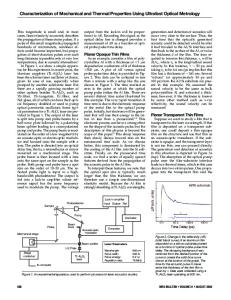Thermal and Mechanical Properties of Diamond-Like a-C:H Films
- PDF / 267,356 Bytes
- 6 Pages / 420.48 x 639 pts Page_size
- 87 Downloads / 341 Views
THERMAL AND MECHANICAL PROPERTIES OF DIAMOND-LIKE a-C:H FILMS G. AMATO*, G. BENEDETTO*, L. BOARINO*, F. DEMICHELIS**, C. F. PIRRI**, R. SPAGNOLO* AND A. TAGLIAFERRO** * Istituto Elettrotecnico Nazionale Galileo Ferraris Strada delle Cacce 91, 10135, Torino - Italy ** Politecnico di Torino, Dipartimento di Fisica Corso Duca degli Abruzzi 24, 10129, Torino - Italy ABSTRACT Diamond-like amorphous carbon and hydrogenated amorphous carbon films (DLC) prepared by rf sputtering have been characterized by means of measurements of optical gap, hardness and Young's modulus. Preliminary results of the application of the photothermal displacement technique (PTD) are also reported, confirming that this method can in principle be applied for a more complete characterization of DLC films at room temperature and low temperatures. INTRODUCTION Diamond-like amorphous carbon (a-C) and hydrogenated amorphous carbon (DLC) have received a great deal of attention in the last few years. Typical DLC is characterized by high hardness, scratch resistance, chemical inertness, high electrical resistivity, good transparency in the IR region, making it suitable for application as a coating. All these physical properties strongly depend on the microstructure of the film. The physical properties of DLC films derive from the relative amount of sp3 sp2 hybridization of carbon atoms. Though many efforts have been made to study the optical and structural properties, there is a lack of data on thermal and mechanical properties of the DLC films. In this paper we report the preliminary results of the application of the photothermal displacement technique (PTD) to DLC samples. This technique is one of the photothermal methods which have been developed for nondestructive material inspection in the last decade. The basic process of all these methods is the heating of a sample, via nonradiative deexcitation, as a consequence of the absorption of optical energy. Application of photothermal methods include high sensitivity measurements of optical, thermal and thermoelastic parameters of the materials. PTD is based on non-contact optical detection of the thermoelastic deformation of the sample surface. The main advantage of this technique is related to its peculiarity to perform measurements in vacuum and therefore at low temperatures. According to theory [1,2], the signal is mainly determined through the thermal expansion coefficient a of the material, its thermal conductivity k and thermal diffusion length gth= (2k/pcco)1/ 2 , where p, c, and ciodenote the mass density, specific heat and modulation frequency, respectively. For a given radius r of the pump beam and thermal length, to first order the signal is proportional to the ratio a/k. To get more detailed information on the characteristics of DLC films, measurements of optical gap, hardness and Young's modulus have been also performed. The correlation among the different experimental results leads to a better understanding of the film structure and properties.
Mat. Res. Soc. Symp. Proc. Vol. 270. 01992 M
Data Loading...











